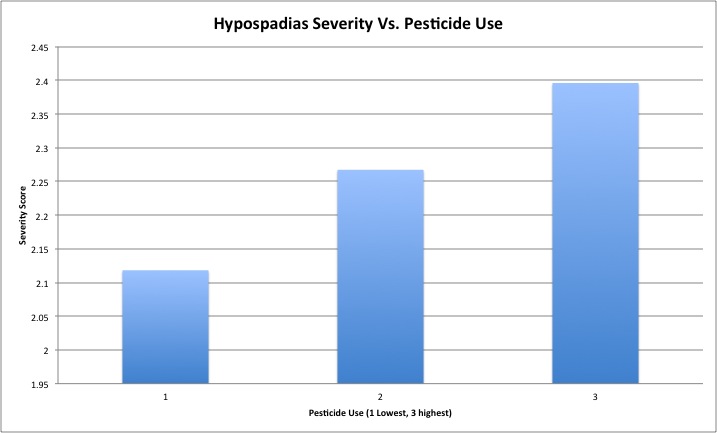-->
|
Back to 2014 Fall Congress Meeting Abstracts
HYPOSPADIAS SEVERITY CORRELATES DIRECTLY WITH THE USE OF AGRICULTURAL HERBICIDES AND PESTICIDES
Weston Kitley, BS, Martin Kaefer, MD, Catherine Proctor, BS, Rosalia Misseri, MD, Benjamin Whittam, MD, Katherine Hubert, MD, Richard Rink, MD, Mark Cain, MD, Paul Winchester, MD.
Indiana University, Indianapolis, IN, USA.
Introduction: Hypospadias is one of the most common congenital urologic anomalies, occurring in approximately one in every 250 live male births. In both Europe and the United States the number of reported cases has been increasing over the past three decades. In addition, there has been an increase in the prevalence of severe cases. One possible reason may be an increased exposure to environmental teratogens. Agricultural herbicides and pesticides may prove especially important because many work on a mechanism that can alter the hormonal milieu. We sought to evaluate whether the prevalence and/or severity of hypospadias is altered in counties where there has been a higher total local field application of these agricultural chemicals.
Materials and Methods: After obtaining IRB approval we retrospectively collected data on all patients from 2000-2011 who presented with a diagnosis of hypospadias. Charts were reviewed for the variables of patient date of birth, county of birth and CPT code for the operation performed. Each case was assigned a weighted number score of either 1 = glanular, 2 = distal shaft, 3 = mid shaft, 4 = proximal shaft or 5 = perineal. To determine prevalence in each county we used published statistics of live births for the same twelve-year span. Using published data on number of metric tons of agricultural herbicides and pesticides applied per county we then compared the prevalence and severity of cases within low (less than 250,000 pounds), medium (between 250,00 and 372,000 pounds) and high (greater than 375,000 pounds) exposure counties.
Results: Between 2000-2011 there were 2,165 patients who underwent surgery at our institution with a diagnosis of hypospadias. An overall prevalence of 0.0048 was noted which correlates well with previously reported prevalence of this disorder (i.e. one in every 250 (0.004) live births). The average severity of hypospadias was 2.118, 2.267, and 2.396 for low, medium and high exposure counties, respectively (p = 0.046). Overall prevalence of hypospadias was 0.00492, 0.00471, and 0.00461 for low, medium and high exposure counties, respectively (p value 0.658).
Conclusions: The severity of hypospadias is higher in areas where there is a greater burden of applied agricultural-based herbicides/pesticides. No apparent correlation between the prevalence of hypospadias and the magnitude of field-applied agricultural chemicals was apparent within our cohort. This data suggests that environmental exposure to certain endocrine disruptors present in an agricultural setting may modify the expression of a genetically based disorder.

Back to 2014 Fall Congress Meeting Abstracts
|


